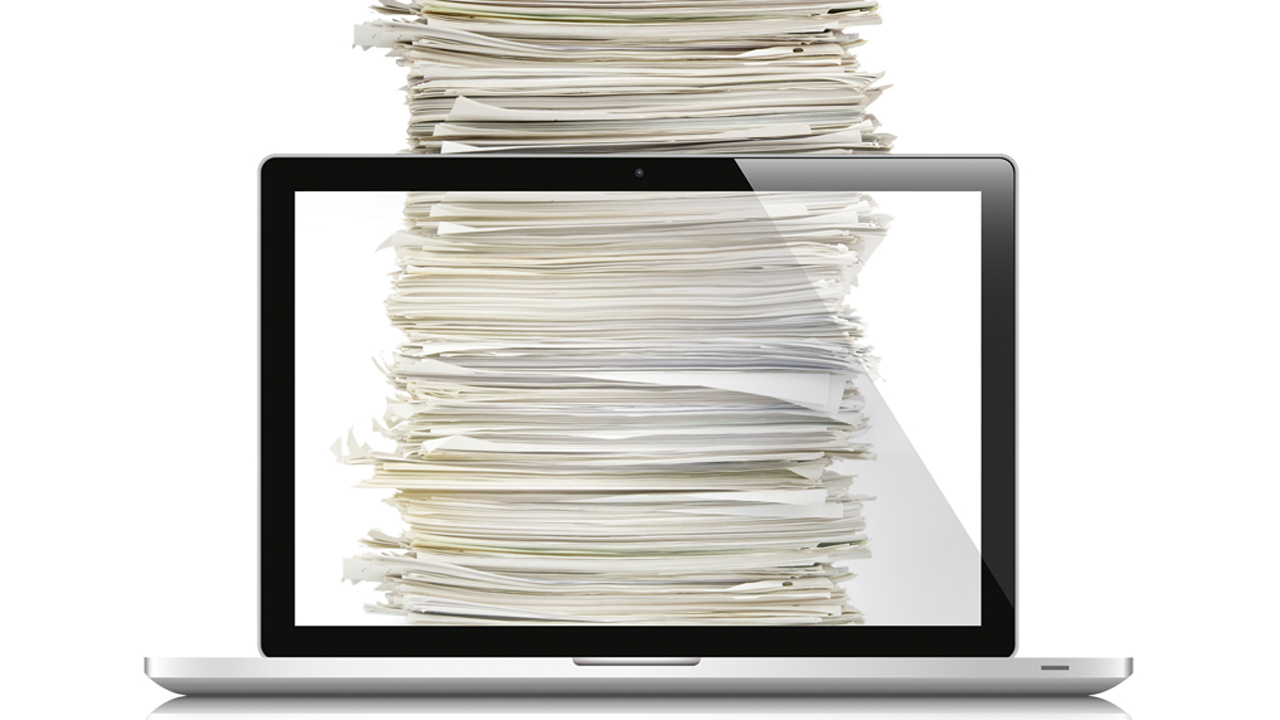Once upon a time… There was paper
By Wojciech Czaja , 25.11.2017

The paperless office revolution has failed to materialise. A certain paper diet can nevertheless be observed. Where to put the data? What has to be adhered to? And what possibilities are opened up to the new surfaces? An essay about the real and virtual storage areas in our office.
“Our entire office currently operates more or less without paper,” said Andreas Gnesda. The always well-groomed 49-year-old leads us through his 380 square metre sized office realm in Vienna-Mariahilf and indicates the creative spaces, which are recreations, for example, of a Viennese coffeehouse, a fireside lounge or a birch grove. Gnesda works non-territorially, he selects his workplace anew depending on the requirements, based on whim, every day…well actually every hour. And that, he says, is only possible when one doesn’t have to fiddle around with ten folders the whole time and piles of notes and receipts etc. “But should I confess something to you? I am in fact a supporter of the paperless, electronic office but I can’t and also won’t do entirely without paper.”
The words of the real estate service provider and consultant Gnesda give good insight into the latest developments in the field of office organisation and workplace design. Large companies, according to the Managing Director of team Gnesda, have no choice but to gradually change over from paper to bits and bytes. “Companies are becoming increasingly more mobile and increasingly decentralised, work steps increasingly differentiated, communication processes increasingly important. In addition, people frequently work in offices without a fixed workplace – for example in a home office, in the field or in a shared space. Such a plethora of paper is consequently no longer manageable.”
Up to 75 percent less paper needed
Yet what are the consequences when paper is banned, when the data required for the work is only available virtually? “No worries,” soothed Bernhard Herzog, Head of Research and Development at strategy consultant M.O.O.CON, “The data is not 100 percent virtual, nor will it ever be. However, I actually noticed in project developments, which we recently accompanied, that the demand for paper for medium-sized and larger companies has declined by up to 75 percent.”
The latter “25 percent paper”, of which Herzog speaks, are indispensable to the creative and idea generation process. In addition, the originals of sensitive documents, such as contracts, for example, are signed, as long as the technical and legal sticking points have not yet been worked out and as such also have to be stored. And not least of all there are valuable “legacy issues” (O-Ton Herzog), which complicate subsequent digitalisation: “To scan in historic plans, drawings, photographs and complete records from the past … this is labour and time intensive and hence also quite expensive. I think that in these areas no substitute will be found for paper for the time being.”
More aesthetics, more overview, more space savings
The only question remains: Where to put all those reams? And above all: What to do with the paperless rest? “Archiving and storage in paper form is no longer being done in the immediate workplace area but is increasingly stored in central storage facilities,” explained Oliver Pestal from designfunktion. “Depending upon spatial circumstances this is either in a cellar, in the heart of the building or in external warehouses through the purchase of the corresponding additional service, which makes it possible for Box XY to be retrieved from the archive on request, delivered to the office and placed on my desk.” The benefit of this removal to central storage: Firstly a more aesthetic office, secondly an improved overview of the files, thirdly space saving in storage and ultimately also the entire surface area of the property.
“I warn against centralising the storage area solely for reasons of efficiency,” explained Bernhard Kern, Managing Director of Roomware Consulting GmbH. “Naturally I can design the workplace more efficiently when I work digitally and no longer have to operate with piles of notes and receipts and open folders. However, the paperless or paper-saving open plan office is ultimately not about giving the employee more space but about offering them an added value of comfort, well-being and more options for their workplace.”
Step by step and with a system to the paperless office
A few important steps are to be observed to ensure a smooth orientation in the virtual realm. It is called “Enterprise Content Management” (ECM) in the technical jargon. “If I decide on a paperless office then this changeover should be implemented consistently and thoroughly,” advised Heino Schneider, Managing Director of German bitfarm. “It is important for electronics to replace paper, not supplement it – be it inbound and outbound documents, plan files or internal communication processes. When invoices are scanned as a supplement, experience shows that chaos will at some point arise.”
A redundant and hence secure system is in any event required, in the opinion of the head of the company established in the year 2000, which has specialised in the development of its own open source software as well as in the related services. “In any event I advise redundancy in terms of a storage on two different servers. If one fails I can always still access the other. Paper, however, should no longer be part of the game here anymore.” Furthermore, attention has to be paid to correctly tagging the documents, to standardised search and find processes, as well as above all to the time factor. Schneider: “Such a changeover from paper-based to electronic filing doesn’t go from 0 to 60. People waste a lot of time on this one! I would advise structuring the changeover by departments or formats and doing it step-by-step.” As a rule this process takes medium-sized companies three to six months, for larger companies the changeover could easily take two to three years.
Let’s go digital!
“The future will be digital, there’s no way around it,” opined Karl Heinz Mosbach, Managing Director of ELO Digital Office GmbH, whose company provides support in Austria and Germany. “For us to get a grip on this future I recommend using standard formats, which guarantee readability of the data even after many years, as well as a sufficient back-up system.” The data also has to be saved in revision-proof, hence not rewritable data formats, such as TIFFs or PDFs. Mosbach: “My vision is that in the future we will use digital storage not only as an archive for documents that are no longer in use but also as a platform for current, collaborative, team-oriented day-to-day work processes.” In future, according to the predictions, desks will be smaller, file cabinets removed or dispensed with and data will disappear into the virtual realm. Thus by designing workplaces and the associated communication paths the previously misaligned spaces are opening up.




